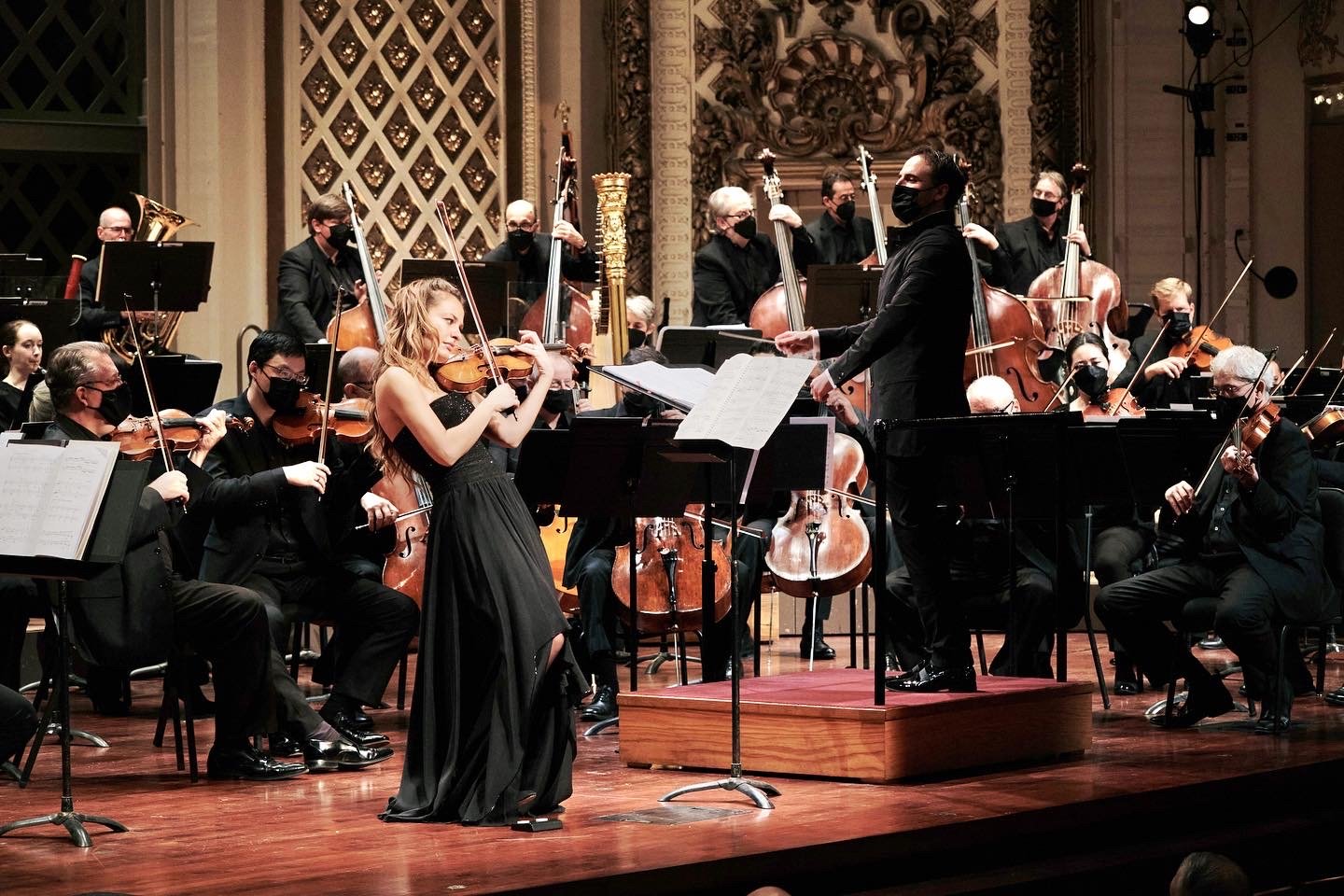Nicola Benedetti receives top praise for U.S. Premiere of Mark Simpson Violin Concerto
Nicola Benedetti performing Mark Simpson’s Violin Concerto at Cincinnati’s Music Hall with the Cincinnati Symphony and conductor François López-Ferrer (Photo credit: JP Leong)
REVIEW: Benedetti, Cincinnati Symphony Orchestra dazzle in U.S. premiere of Simpson Violin Concerto
By Janelle Gelfand
Cincinnati Business Courier
January 14, 2022
Violinist Nicola Benedetti soared fearlessly through the agitated finale of Mark Simpson’s Violin Concerto with the Cincinnati Symphony Orchestra on Friday, and cheers erupted in Music Hall. It was a thrilling finish to a substantial new piece that seems destined to enjoy life long after these performances.
The Cincinnati Symphony morning concert, which opened with the U.S. premiere of Simpson’s Violin Concerto, was led by the orchestra’s associate conductor François López-Ferrer, who stepped in this week for music director Louis Langrée. Langrée has contracted the flu, the orchestra said. The program also included Richard Strauss’ “Der Rosenkavalier” Suite and Ravel’s “La valse.”
Simpson’s new concerto is massive in scope. Commissioned by the London Symphony Orchestra (which gave the world premiere in a livestreamed performance last April), the Cincinnati Symphony Orchestra, WDR Sinfonieorchester and the Royal Scottish National Orchestra, it is nearly 40 minutes in length. For Benedetti, for whom it was written, the concerto called for almost nonstop virtuosities and there was frenzied playing throughout by both soloist and orchestra.
Simpson is a gifted young British composer, whose haunting oratorio, “The Immortal,” was premiered at the May Festival in 2019. He began his Violin Concerto before Covid-19 shut down the world. As he, and everyone else, endured the pandemic lockdowns, the piece became his personal response to the worldwide crisis.
Many composers have written music in response to crises in history. In a YouTube interview for the London Symphony, Simpson said of the pandemic, “I was a witness to it, really, or kind of a vehicle for it.”
If you followed his program note, the concerto unfolded as a kind of tone poem for violin and orchestra. He cast it in five unbroken movements, opening with a “Lamentoso” – a lament for the pain and suffering experienced throughout the pandemic. The second movement referred to pent-up energy that he could not release during lockdown. The third was a love song “tinged with moments of darkness.”
He scored it densely for a large orchestra, several times using the brass to make bold statements. The extensive percussion section included timpani, drums, castanets, glockenspiel, bongo drums, gongs, bells, whip and harp.
Benedetti’s performance was a tour-de-force, both technically and emotionally. Not only was she utterly committed to the music, but she performed with relentless intensity from beginning to end and made it look effortless.
The opening theme of the “Lamentoso” was rhapsodic, featuring sliding notes and a slightly exotic melody. Against Benedetti’s violin, the orchestral canvas was bright, with fleeting colors in winds and brass and tremolo in the strings. As the violinist’s music became more daring in the “Dance,” the orchestra provided busy textures and intense punctuations. Benedetti was frequently in dialogue with the percussion section, trading phrases in the highest register of her instrument against insistent drumming and whip cracks.
The heart of the work was the third movement, which opened with a sighing motif in low brass and winds. Here Benedetti’s playing was impassioned, as if coming from somewhere deep inside. A gong summoned a darker, mournful turn. In the all-too-brief lyrical moments, the soloist displayed a big vibrato and a glowing tone.
A brilliant cadenza formed the fourth movement. The violinist began in high harmonics with murmurings, trills, glissandos and left-hand pizzicatos. Then the composer seemed to throw in every kind of technical challenge, like a Paganini etude, with one treacherous passage after another. The finale, a tarantella, was supercharged. The orchestral score included a rhythmic march with castanets and cacophonous, brass-filled climaxes. Benedetti’s playing dazzled in every moment of it.
To read the full review, click here.

